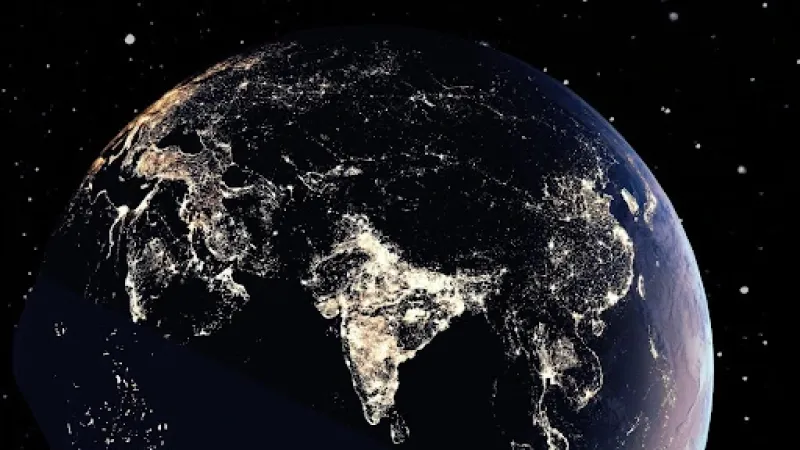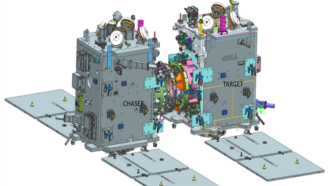
India, the most populous country with 1.4 billion people and a rapidly growing economy, requires a lot of electricity. While the country still draws much of its power from fossil fuels, it is aggressively transitioning toward renewable energy (RE) sources, such as solar and wind. According to the Ministry of New and Renewable Energy, India has achieved a milestone where over 50% of its installed power capacity is sourced from non-fossil fuels. The nation has an ambitious target to reach 500 GW of renewable energy generation capacity by 2030. To efficiently manage our resources, understanding and predicting electricity consumption is crucial.
New research from the Vellore Institute of Technology, Chennai, and UOW Malaysia KDU University College, Malaysia, has now developed a method to forecast the nation's energy demands from space at night with remarkable accuracy. The researchers developed a novel way to predict the electricity consumption of individual states by analysing nighttime satellite imagery.
The research team collected and analysed night light satellite images from NASA's VIIRS satellite and its Black Marble product suite (VNP46A2 and VNP46A4). These images, captured daily and yearly, provide detailed information about the intensity of light emitted from Earth's surface at night. They use tools like Google Earth Engine (GEE) and NASA's LAADS-DAAC to access and process the vast datasets. To ensure data quality, they filtered out pixels with low radiance values. They handled any missing data points using a simple yet effective linear interpolation method, averaging values from adjacent days to fill in the gaps.
Next, they collected actual daily electricity consumption data for India from the Power System Operation Cooperation (POSOCO) website, spanning from April 2012 to December 2023. This data, measured in Million Units (MU), was obtained by scraping monthly reports. They also gathered state-wise electricity consumption data for a slightly shorter period.
Did You Know? India ranks fourth globally in terms of total installed Renewable Energy capacity. It holds the fourth position in wind power and the third position in solar power capacity. |
Their forecasting used deep learning models, specifically variants of Long Short-Term Memory (LSTM) networks. LSTMs are a type of neural network particularly adept at handling sequential data, like time series, because they can “remember” information over extended periods. The researchers experimented with several LSTM architectures, like Stacked LSTM, Bidirectional LSTM, Convolutional Neural Networks (CNNs)-LSTM and ConvLSTM.
The team broke down consumption by state, utilising a technique called clustering to group states with similar energy consumption patterns. The process revealed four distinct clusters of states, which allowed for even more tailored and accurate forecasts. The bidirectional LSTM model, in particular, stood out, demonstrating superior performance in multivariate forecasting, meaning it performed best when considering both electricity consumption history and night light data. ConvLSTM was found to make highly accurate predictions tailored to a group's unique energy profile for cluster-specific forecasts.
They also conducted statistical significance tests, like the Wilcoxon signed-rank test and the Friedman test, to compare model performances and ensure the reliability of their findings. An external validation was also performed on a completely unseen dataset from early 2024 to objectively assess the models' generalizability to new, real-world data.
Their study reveals a strong correlation between the brightness of cities at night and the amount of electricity being used. They've shown that deep learning networks can use these night lights to predict future energy demands with precision. The models achieved high accuracy, with Mean Absolute Percentage Error (MAPE) values below 10% and Root Mean Squared Error (RMSE) values, which measure the error rates in the prediction, well below 20 Million Units (MU), a significantly low value for such a complex task.
The research highlights the predictive power of night light data for estimating granular, state-wise electricity consumption. It also demonstrates the accuracy of deep learning models, particularly Bidirectional LSTM, in handling large, sequential datasets and capturing intricate temporal and spatial dependencies. The state-wise clustering approach is also a notable improvement, allowing for more nuanced and localised forecasts compared to country-level predictions. The automated feature extraction capabilities of deep learning also reduce the manual effort often required in traditional ensemble models.
However, the study acknowledges the unavailability of daily GDP and population data, which are typically only accessible at monthly or annual intervals. Incorporating these variables daily could further enhance forecast accuracy, but would require more sophisticated data acquisition or imputation techniques. Another inherent limitation stems from the nature of night light imagery, which primarily reflects electricity used for illumination in households, commercial areas, and streets. It doesn't capture electricity consumed by industries or other activities that don't function at night or don’t produce visible light. Furthermore, the VIIRS satellite's overpass time at 01:30 UTC nightly means it misses peak human activity and lighting, which typically starts by 6 PM ends by 11 PM local time. This timing could lead to a loss of crucial information about peak energy demand.
Despite these limitations, the study's findings robustly establish the strong correlation between night lights and electricity consumption, providing a valuable foundation for future research. By harnessing the silent glow of cities from space and combining it with deep learning, policymakers and energy planners can now access more accurate and reliable forecasts of electricity consumption. As India continues its rapid growth, the insights from this study will be instrumental in powering its progress responsibly, ensuring a brighter, more sustainable future for all its citizens.
This article was written with the help of generative AI and edited by an editor at Research Matters.






